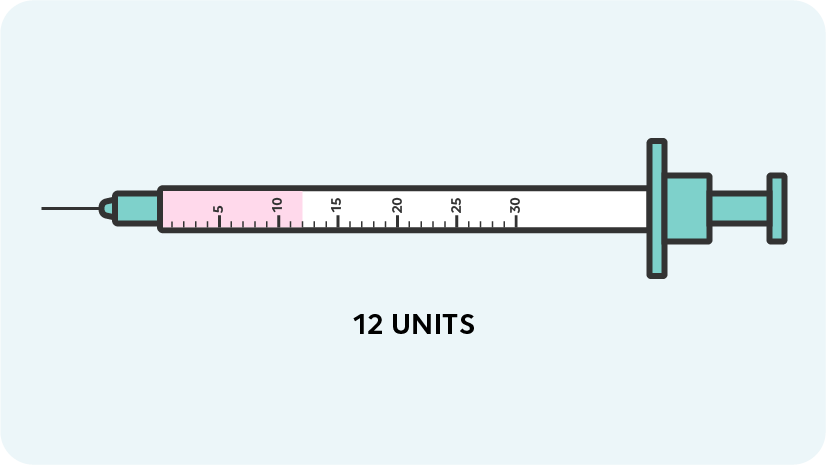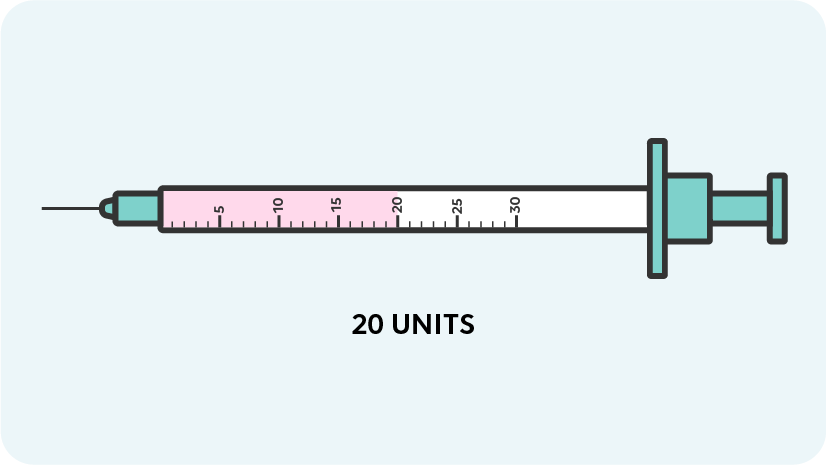Microdosing GLP-1 (Injection) Product Guide
Microdosing GLP-1 is a low-dose prescription of Compounded Semaglutide. GLP-1 medications like Semaglutide are primarily used to treat type 2 diabetes and weight loss. When taken in small doses, known as microdosing, our medical experts anticipate GLP-1 may optimize health and longevity benefits.
Before you get started, read more about important usage information for Microdosing GLP-1.
Quick tips
Here are some simple steps to help you get the most from each dose:
- Refrigerate your vials upon arrival
- Take Compounded Semaglutide on the same day each week
- Can be taken with or without food
- Rotate injection sites every week
- Be sure to properly discard your vials & syringes
Follow these tips to ensure that the medication is properly administered, so you can experience the best possible benefits while minimizing side effects.
Getting started
When you first receive your prescription, ensure proper storage guidelines to maintain the quality of the solution.
Follow the instructions for properly drawing and administering your medication.
Always dose according to your doctor-guided titration schedule.
Explore Microdosing GLP-1 benefits so you know what to expect. Learn the best strategies for reducing potential side effects.
Storage
To maintain the utmost quality, it is best to refrigerate your vials between 36°F and 46°F. If your vial has been stored below 36°F or above 46°F for an extended time, the solution may become ineffective.
All vials indicate the date by which the medication should be used, which will be 180 days after the medication was compounded. Please use the medication before the beyond-used date (BUD).
Once you pierce the vial, the solution will last for 28 days. You must discard pierced vials after 28 days, even if there is still some solution remaining—this applies to all multi-dose vials (MDVs).
Upon receiving your medication, check the temperature of the vials with the back of your hand. If it feels hot to the touch, please contact us immediately.
You may safely travel with your vials so long as the above conditions are met while traveling. Be sure to travel with a refrigerated case if necessary, and to bring your own sharps disposal container if you will not have access to one.
Drawing and administering
How to draw your solution
Before your first use, take the time to review how to properly draw your solution.
Next, ensure that you are drawing the correct amount of solution according to your titration schedule. Your current dose will always be displayed on your vial – use this as a reminder before you begin.
It is important to sterilize the top of the vial with an alcohol wipe each time before drawing up the solution.
How to measure units on your syringe
If you’re new to subcutaneous injections, follow this quick guide to understand the measurements on your syringe.
Your weekly doses are measured in milliliters (ml) to units. Before getting started, check to see how many units are in your weekly dose.
The label on your subcutaneous syringe shows units. Each unit represents 0.01ml, so every 10 units represents 0.1ml.
Each small line on the syringe represents 1 unit, and each large line represents 10 units. So, if your dose calls for 20 units, simply draw your solution up to the line that reads “20.”
If your weekly dose calls for a measurement not clearly labeled on the syringe (like 25 units), pay close attention to the markers between the large lines when drawing up your dose. There may be even smaller measurement lines on the syringe that are more difficult to see. Count these carefully as you draw up your dose to ensure the most accurate measurement.


How to administer your solution
Compounded Semaglutide is delivered via subcutaneous injection, which means that you will inject the solution into a fatty layer of tissue, such as your abdomen or your thigh. If you’re new to self-administered injections, take the time to review how to properly administer your injection before proceeding.
As a general rule, you should grip the syringe with your dominant hand, and grasp the injection site with the other hand.
If you can grasp at least 2 inches of skin, then deliver the injection at a 90° angle (or, straight in). If you cannot grasp at least 2 inches of skin, deliver the injection at a 45° angle.
To avoid irritation, try switching injection sites each week. You can take Compounded Semaglutide with or without food, and at any time of day, but try to be as consistent as possible to ensure the best outcomes.
After you have administered your injection, discard the needle and syringe in an FDA-approved sharps container. Never reuse the needle or the syringe once it has been used.
Microdosing GLP-1 titration schedule
Microdosing GLP-1 is always prescribed with a doctor-guided titration schedule to gradually introduce the medication to your body. This way, you have the best opportunity to experience the greatest benefits possible while reducing side effects.
Your titration schedule is always available on your AgelessRx portal.
If you miss a dose, you can skip the dose you missed and take it the next day. Never take more than your prescribed dose. If more than 2 weeks have passed since your last dose, please contact your prescriber for further guidance: you may be asked to restart your titration.
Note: Patients who would like to switch to a higher dose than their maximum prescribed dose must switch to a full-dose GLP-1 prescription. If you feel you are not meeting your health goals on your prescribed dose, contact your prescriber.
Side effects
Microdosing GLP-1 is a low-dose Semaglutide prescription, which may result in lower risk and severity of potential side effects.
Compounded Semaglutide (Injectable) has not been evaluated by the FDA, but side effects are expected to be similar to other Semaglutide-based medications reviewed by the FDA, which have the following side effects: nausea, diarrhea, vomiting, constipation, abdominal (stomach) pain, headache, fatigue, dyspepsia (indigestion), dizziness, abdominal distension, eructation (belching), hypoglycemia (low blood sugar), flatulence (gas buildup), gastroenteritis (an intestinal infection) and gastroesophageal reflux disease (a type of digestive disorder).
Common side effects normally go away on their own within a few days or up to 2-3 weeks. If you find that any side effects persist for longer than this or get worse over time, stop taking your medication and contact your prescriber as soon as possible.
To help prevent side effects from occurring or persisting, try the following:
- Eat slower and at more regular intervals throughout the day
- Try to take your medication at around the same time each day
- Drink water before taking your dose
- Avoid fried, greasy foods in favor of healthier, low-fat options
Dehydration may also be an indirect side effect for those experiencing vomiting and diarrhea. If you do experience these side effects, make sure that you are drinking plenty of water and fluids with electrolytes to avoid dehydration. If you’re unable to keep water down due to vomiting, seek immediate medical attention.
For some patients, taking probiotics may help reduce gastrointestinal side effects, but results may vary. Ginger and peppermint oil may also help to reduce gastrointestinal side effects.
This is only a summary of potential side effects and how to address them. For more information, please reference the Mayo Clinic’s Semaglutide resources, or ask your prescriber.
Serious side effects
GLP-1 medications like Semaglutide have been associated with the following rare but serious side effects.
- Thyroid C-cell tumors
- Diabetic retinopathy
- Hypoglycemia
- Kidney problems
- Gallbladder problems
- Pancreatitis
- Worsening of mood
- Bowel obstruction
- Osteopenia (loss of bone density)
- Changes in heart rhythm
Your AgelessRx prescriber will weigh these potential risks against your unique medical history when considering a prescription.
For a full list of potential warning signs for these conditions, please see the Mayo Clinic’s Semaglutide resources.
Important safety information
Microdosing GLP-1 should not be used by anyone who has a personal or family history of medullary thyroid carcinoma (MTC), multiple endocrine neoplasia syndrome 2 (MEN2), or pancreatitis.
The FDA is currently evaluating whether GLP-1 medications may increase the risk of suicidal thoughts or actions. Though the FDA has found no evidence supporting this risk, patients with a history of suicidal thoughts should not take Microdosing GLP-1.
Do not use your medication if you are pregnant or breastfeeding, or planning to become pregnant or breastfeed.
Though rare, allergic reactions to Semaglutide are possible. If you notice any shortness of breath or swelling around your face, tongue, or throat after using your treatment, stop use immediately and contact emergency services right away.
As with any prescription medicine, the dose prescribed is for you and you alone. Do not, under any circumstances, allow anyone else to use your treatment.
Note: The above statements have not been evaluated by the Food and Drug Administration. This product is not intended to diagnose, treat, cure, or prevent any disease.
Additional resources
-

How to Get GLP-1 Naturally
Increase your body’s natural GLP-1 levels and take control of your health with easy, science-backed tips and lifestyle changes!
-

GLP1s for Weight Loss and Diabetes Explained
Learn how GLP-1s aid in weight loss and diabetes management by regulating blood sugar, reducing appetite, and improving heart health.
-

Which GLP-1 Is Best for Weight Loss?
What is the best GLP-1 for weight loss? Compare Wegovy & Ozempic to find the option that fits your unique health goals.
